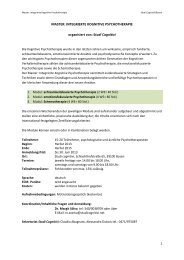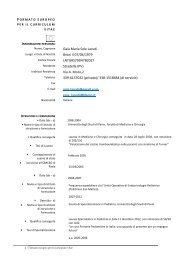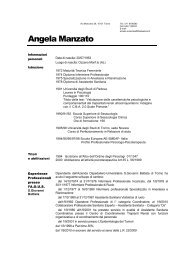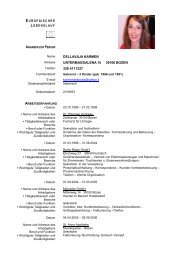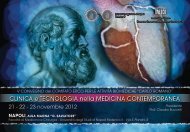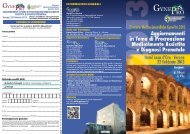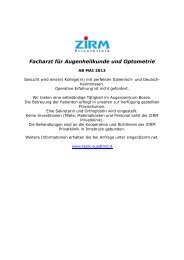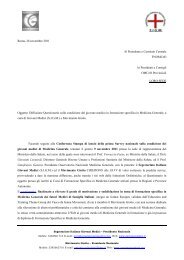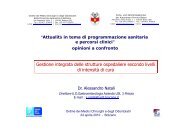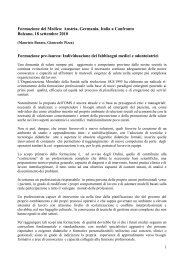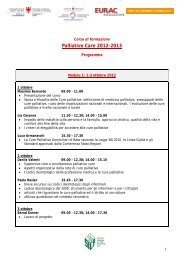Numero 11 - Istituto Superiore di SanitÃ
Numero 11 - Istituto Superiore di SanitÃ
Numero 11 - Istituto Superiore di SanitÃ
You also want an ePaper? Increase the reach of your titles
YUMPU automatically turns print PDFs into web optimized ePapers that Google loves.
Ricerca scientifica<br />
Approcci innovativi<br />
per lo stu<strong>di</strong>o delle malattie rare<br />
in brief<br />
Scientific research. Innovative approaches for the study of rare <strong>di</strong>seases.<br />
In the world there are close to 7,000 known rare <strong>di</strong>seases: these orphan ailments have a significant collective<br />
impact. Research aims at fin<strong>di</strong>ng the causes and ultimately treatments for these <strong>di</strong>sorders could benefit millions of<br />
people. This is especially so given that research on rare <strong>di</strong>seases often provides insight into more common <strong>di</strong>seases.<br />
Research is fundamental in this field, because for the most of the rare <strong>di</strong>seases, molecular mechanisms lea<strong>di</strong>ng to the<br />
insurgence of the pathology are still unknown, so it is not possible to have a useful care. In the Laboratories of the Unit<br />
of Orphan Drugs at the National Center for Rare Diseases, scientists perform basis researches in the fields of cellular and<br />
molecular biology, and neuropathogenesis, with the aid of very powerful experimental techniques, to better understand<br />
pathological mechanisms underlying several rare <strong>di</strong>seases. A summary of the methodologies used, and of the activities<br />
carried on by these researchers is here described.<br />
La ricerca sperimentale ha un ruolo fondamentale<br />
nel campo delle malattie rare (MR) poiché,<br />
per molte <strong>di</strong> queste, restano ancora sconosciuti<br />
i meccanismi molecolari che portano all’insorgenza<br />
dalla patologia, e ciò rende impossibile fornire una<br />
cura adeguata. Lo sviluppo <strong>di</strong> nuovi approcci sperimentali<br />
che si avvalgano <strong>di</strong> tecniche innovative e ad<br />
alto profilo tecnologico risulta quin<strong>di</strong> importante per<br />
giungere, in tempi ragionevoli, a una comprensione<br />
dei meccanismi alla base della malattia e poter così<br />
pensare a una risposta adatta.<br />
Nell’ambito delle attività del Reparto Farmaci<br />
Orfani del Centro Nazionale Malattie Rare (CNMR)<br />
dell’<strong>Istituto</strong> <strong>Superiore</strong> <strong>di</strong> Sanità vengono svolte ricerche<br />
<strong>di</strong> base in cui vengono utilizzate <strong>di</strong>verse meto<strong>di</strong>che<br />
sperimentali, che presentano un’elevata potenzialità ai<br />
fini della comprensione dei meccanismi patologici che<br />
sono alla base delle MR.<br />
Surface Plasmon Resonance (SPR)<br />
Una delle maggiori sfide della ricerca nella biologia<br />
cellulare e molecolare è capire il rapporto tra le caratteristiche<br />
strutturali delle macromolecole biologiche e<br />
la loro funzione. La comprensione dei meccanismi che<br />
controllano i processi cellulari richiede la conoscenza<br />
<strong>di</strong> come l’attività delle proteine, le interazioni e la<br />
formazione dei complessi, sono regolati all’interno<br />
della cellula.<br />
Questo tipo <strong>di</strong> stu<strong>di</strong> può essere condotto attraverso<br />
l’impiego dei sistemi Biacore, che consentono<br />
<strong>di</strong> analizzare in tempo reale le interazioni tra molecole<br />
biologiche (Real-time Biomolecular Interaction<br />
Analysis).<br />
In questi sistemi le interazioni hanno luogo sul<br />
sensor chip, una slide <strong>di</strong> vetro ricoperta da un lato<br />
da una sottile lamina d’oro a cui è covalentemente<br />
legata una matrice che costituisce il supporto per il<br />
ligando; l’analita in esame viene iniettato attraverso<br />
l’IFC (Integrated μ- Flui<strong>di</strong>c Cartrige, contenente<br />
canali per il flusso, sample loop, valvole pneumatiche)<br />
che controlla il trasporto dei campioni sulla superficie<br />
del sensor chip. In questo modo, il contatto tra le<br />
molecole avviene in flusso costante e non in maniera<br />
statica e ciò permette <strong>di</strong> valutare i parametri cinetici<br />
dell’interazione.<br />
La tecnica utilizzata non prevede marcatura delle<br />
sostanze che interagiscono, quin<strong>di</strong> la conseguenza <strong>di</strong><br />
questa caratteristica è che l’interazione tra molecole è<br />
monitorata in tutte le sue fasi contrariamente a molti<br />
meto<strong>di</strong> convenzionali, in cui la rilevazione è ristretta<br />
alle singole componenti marcate.<br />
10 Not Ist Super Sanità 20<strong>11</strong>;24(4 Suppl. 1):10-13



